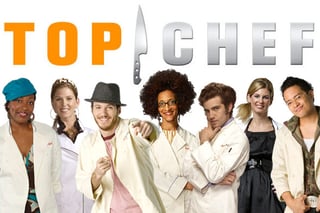Welcome to this week’s TBT post, originally published in 2010.

For some reason that I can't explain, I really like the show Top Chef. I am not sure why since the most complicated dish I can whip up is tuna fish casserole. In the show, they have team events that generally prove to be the undoing of one of the contestants. The problem is that all the chefs are supposed to generate a meal for the judges, but with all the egos and strong personalities, it is difficult for them to distill a singular vision to create a compelling meal. The team leader that harnesses this energy usually wins and the one that doesn't goes home.
We announced today that we are embarking on a product study around expanding our DesignState Integration platform to address mechatronics (see press release). This issue was brought to our attention by several clients and partners as an ongoing challenge for companies trying to integrate design information for electrical, mechanical, and software components for their products. Historically, our product development efforts were usually driven and funded by one or two of our clients. Our original DesignState architecture was developed in response to some specific requirements from John Deere and then further extended by requirements from Cisco, Paccar, Harris and Raytheon. The nice thing about this approach was that we had customers right out of the gate but the challenge was that the feature set was very specific and had limited appeal to a broader market. As we have geared up for this new product release and I now find myself calling the shots, I wanted to cast a broader net as we move forward with this new product release.
I have come across a couple of relevant opinions when it comes to market research. I recently attended a meeting where Rob Adams, founder of AV Labs and currently a faculty member of the Management Department at the University of Texas was speaking about market validation. His book, "If You Build It Will They Come?" explores the mechanics of market validation and how to figure out what the market really wants to buy versus what customers say they want. He emphasizes how important it is to get on the phone and to talk with clients and see how important the problem your solving is to them. He doesn't really address social media as a mechanism to interact with clients which I think is a potential oversight. Another opinion I encountered was courtesy of Erin Sheehan Daly from PTC. She had left a comment about one of my previous blog articles and in the comment she mentioned an interview with IDC's Mike Fauscette on the perils of crowdsourcing. So, the question this blog will attempt to answer is will leveraging crowdsourcing and social media provide a useful conduit of information for product development companies or will the quality of the information be diluted or compromised by the methodology?
Listening to customers or potential customers is always a good idea. I recently read another article that advocated making decisions about products and services as if one of your key clients was in the room with you participating in the conversation. The article's author felt that too many companies are too far removed from their clients and lose sight of what is in their best interest. Adam's is even more emphatic in his book; he cites research that indicates 65% of new products fail and in start- up companies the failure rate is 90%. Ultimately, Adams attributes these high failure rates to inadequate market validation. He cites everybody's favorite whipping boy the Motorola Iridium satellite phone as an example. Motorola obviously identified a need but failed to understand the price point and the feature set for the market. Better market validation would have revealed that most people want to be able to be inside and potentially in moving vehicles when using a phone and that the premium they would pay for communication in remote areas was limited. They also would have learned that people don't like talking into a brick. To avoid these types of debacles Adams recommends allocating 10% of your product development budget and 60 days of time to interview customers and really nail down your product features. I had asked him in the meeting if there was any way to accelerate this using social media and he was dubious. He felt it was critical to have direct interaction with clients, to hear the tone of their voice and to see how willing they would be to spend money with you. He did not feel that you could get this type of experience using surveys and mass communication tools. I don't think this approach completely eliminates crowdsourcing or the leveraging of social media but I think his point is that there is no substitute for direct customer interaction when conducting market validation.
Motorola obviously identified a need but failed to understand the price point and the feature set for the market. Better market validation would have revealed that most people want to be able to be inside and potentially in moving vehicles when using a phone and that the premium they would pay for communication in remote areas was limited. They also would have learned that people don't like talking into a brick. To avoid these types of debacles Adams recommends allocating 10% of your product development budget and 60 days of time to interview customers and really nail down your product features. I had asked him in the meeting if there was any way to accelerate this using social media and he was dubious. He felt it was critical to have direct interaction with clients, to hear the tone of their voice and to see how willing they would be to spend money with you. He did not feel that you could get this type of experience using surveys and mass communication tools. I don't think this approach completely eliminates crowdsourcing or the leveraging of social media but I think his point is that there is no substitute for direct customer interaction when conducting market validation.
We should look closer at Mike Fauscette's comments in his interview with Erin Sheehan Daly. Unfortunately, his report "Product Lifecycle and Wisdom of Crowds" costs $3500 so for this article we must rely on his words from the interview. He doesn't outright reject the value of leveraging customer feedback versus your own profession product development staff but he does discount the value somewhat. He feels professionals should know more about product development than company outsiders. I tend to sympathize with this argument. After all, you should know your business better than anyone else. Fauscette goes on to clarify his position that customers or qualified potential customers fall into a different category when it comes to providing market validation. Since they have a stake in the outcome of your efforts their input will be more valuable. He agrees that reaching out to this segment of the "crowd" could be a valuable activity in helping to determine the right functionality for your product and if your value proposition is compelling enough. Another book on the topic takes this farther, "Blue Ocean Strategy", by W. Chan Kim and Renee Mauborgne advocates mining not just your customers and prospects but competitors and people who currently do not use your product. If you limit your research to a smaller space, then you will have a smaller cap for customers. In order to maximize the earning potential for your product you need to expand your features and value proposition to draw in as many potential customers as possible. By limiting your research to familiar clients, you ensure that your product will have limited appeal.
So, between the four authors we have quite a meal. Rob Adams emphasis on product validation is well founded. Introducing new products into the market without understanding the needs of your target is hazardous to your company's health. His insistence that there are no ways to automate or accelerate this process through social media is sound on one level. Social media and crowdsourcing cannot substitute for direct interaction with potential customers to fully understand their motivations and impressions of your product but certainly can be used on the front end to help identify these prospects. Mike Fauscette's cautionary words on trusting your internal resources and making sure outside advice is provided by those with an investment in the process are wise. You should always evaluate your sources and how relevant your sources are. Our final ingredients from "Blue Ocean Strategy” – which urges us to cast a wider net – directs us to the tools of social media and a broader sampling of information. In conclusion, the answer to our question is that social product development and crowdsourcing can be useful tools in guiding the features of a product but the information must be filtered and reconciled with your internal experience. Hopefully, your company is a thought leader in your market segment and has internal resources that can guide your company forward. We will see how our current study goes and how useful this approach is in helping us address the mechatronics issue in PLM. Bon Appétit.
[Edit: repost from 2010]



